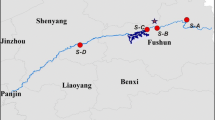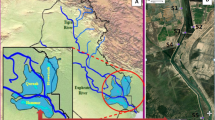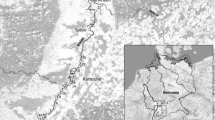Abstract
The purpose of this study was to test the potential role of the aquatic snake Helicops pastazae as an indicator of water pollution caused by heavy metals. In particular, we tested whether the total heavy metal concentration is related to (1) the position (upstream vs downstream) of the sampling point and its distance from the point where wastewater is discharged; (2) the taxonomic group studied: piscivorous snakes vs characid fish that occupy the same habitats; and (3) the organ or tissue examined: snake liver versus muscle. We used atomic absorption spectrophotometry with electrothermal atomization to quantify cadmium (Cd), chromium (Cr) and lead (Pb) and found significant differences between some of the sampling points, with particularly high metal concentrations detected upstream at point 1. However, we found no clear spatial pattern nor any significant differences in the concentration of any of the metals in fish and snake muscle, suggesting that both species accumulate similar amounts of the sampled elements. With regard to interactions, snake liver had the highest concentrations of Cd, while muscle had the highest concentrations of Pb and Cr, which may indicate tissue affinity differences for certain metals. Altogether, our results indicate that H. pastazae accumulates contaminants differentially, depending on the tissue and location, which highlights their potential as bioindicators of water contamination. Further research is necessary to understand their role as bioindicators based on extensive sampling and environmental contaminant data.







Similar content being viewed by others
Availability of Data and Material
The datasets created during and/or analyzed during the current study are stored as Electronic Supplementary Material and available from the corresponding author on reasonable request.
Code Availability
The codes generated and used during the current study are available from the corresponding author on reasonable request.
References
Albrecht J, Abalos M, Rice TM (2007) Heavy metal levels in ribbon snakes (Thamnophis sauritus) and Anuran larvae from the Mobile-Tensaw River Delta, Alabama, USA. Arch Environ Contam Toxicol 53:647–654. https://doi.org/10.1007/s00244-006-0175-3
Almendáriz A, Barriga R, Rivadeneira D (2017) Feeding behavior of Helicops pastazae Shreve 1934 (Serpentes, Colubridae, Dipsadinae) in the Ecuadorian Amazon. Herpetol Notes 10:449–451
Barker D, Allan GL, Rowland SJ, Pickles JM (2002) A guide to acceptable procedures and practices for aquaculture and fisheries research. NSW Government. https://www.dpi.nsw.gov.au/__data/assets/pdf_file/0008/134387/Resource-ACEC-Guide-Report.pdf. Accesed 21 September 2021
Blessing JJ, Marshall JC, Balcombe SR (2010) Humane killing of fishes for scientific research: A comparison of two methods. J Fish Biol 76:2571–2577. https://doi.org/10.1111/j.1095-8649.2010.02633.x
Burger J (1992) Trace element levels in Pine Snake hatchlings: tissue and temporal differences. Arch Environ Contam Toxicol 22:209–213. https://doi.org/10.1007/BF00213287
Burger J, Campbell KR, Campbell TS, Shukla T, Jeitner C, Gochfeld M (2005) Use of skin and blood as nonlethal indicators of heavy metal contamination in Northern Water Snakes (Nerodia sipedon). Arch Environ Contam Toxicol 49:232–238. https://doi.org/10.1007/s00244-004-0098-9
Burger J, Campbell KR, Murray S, Campbell TS, Gaines KF, Jeitner C, Shukla T, Burke S, Gochfeld M (2007) Metal levels in blood, muscle and liver of Water Snakes (Nerodia spp.) from New Jersey, Tennessee and South Carolina. Sci Total Environ 373:556–563. https://doi.org/10.1016/j.scitotenv.2006.06.018
Burger J, Gochfeld M, Jeitner C, Zappalorti R, Pittfield T, DeVito E (2017) Arsenic, cadmium, chromium, lead, mercury and selenium concentrations in Pine Snakes (Pituophis melanoleucus) from the New Jersey Pine Barrens. Arch Environ Contam Toxicol 72:586–595. https://doi.org/10.1007/s00244-017-0398-5
Burger J, Gochfeld M, Rooney AA, Orlando EF, Woodward AR, Guillette LJ (2000) Metals and metalloids in tissues of American Alligators in three Florida Lakes. Arch Environ Contam Toxicol 38:501–508. https://doi.org/10.1007/s002440010066
Campbell KR, Campbell TS (2001) The accumulation and effects of environmental contaminants on snakes: a review. Environ Monit Assess 70:253–301. https://doi.org/10.1023/A:1010731409732
Campbell KR, Campbell TS, Burger J (2005) Heavy metal concentrations in Northern Water Snakes (Nerodia sipedon) from East Fork Poplar Creek and the Little River, East Tennessee, USA. Arch Environ Contam Toxicol 49:239–248. https://doi.org/10.1007/s00244-004-0200-3
Chin SY, Willson JD, Cristol DA, Drewett DVV, Hopkins WA (2013) Altered behavior of neonatal watersnakes (Nerodia sipedon) exposed to maternally transferred mercury. Environ Pollut 176:144–150. https://doi.org/10.1016/j.envpol.2013.01.030
Corpochivor (1996) Plan Ambiental para el municipio de Santa María, Boyacá. 1Library. https://1library.co/document/q2nd01jq-plan-ambiental-municipio-santa-maria-boyaca.html. Accessed 20 November 2018.
Corpochivor (2003) Municipio de Santa María. Esquema de Ordenamiento Territorial: Documento resumen. Santa María. Corpochivor. http://www.corpochivor.gov.co/wp-content/uploads/2015/11/EOT-Santa-Mar%C3%ADa.pdf. Accessed 20 November 2018.
Corporación Autónoma Regional de Cundinamarca, Corpochivor, Corpoboyacá, Universidad Nacional de Colombia (2006) Plan de ordenación y manejo ambiental de la cuenca del río Garagoa—subcuenca río Machetá en la juridiccion CAR. Corporación Autónoma Regional. https://www.car.gov.co/uploads/files/5ac674d6e8eed.pdf. Accessed 20 November 2018
Cusaac JP, Kremer V, Wright R, Henry C, Otter RR, Bailey FC (2016) Effects of maternally-transferred methylmercury on stress physiology in Northern Water Snake (Nerodia Sipedon) neonates. Bull Environ Contam Toxicol 96:725–731. https://doi.org/10.1007/s00128-016-1757-z
EPA (1996) Method 3052: Microwave assisted acid digestion of siliceous and organically based matrices. EPA. https://www.epa.gov/sites/production/files/2015-12/documents/3052.pdf. Accessed 20 November 2018.
FAO/SIDA (1983) Part 9. Analyses of metals and organochlorines in fish. In: FAO/SIDA Manual of methods in aquatic environment research. Roma, pp 33
García-Cobos D, Crawford AJ, Ramírez-Pinilla MP (2020) Reproductive phenology in a Neotropical aquatic snake shows marked seasonality influenced by rainfall patterns. J Nat His 54:1845–1862. https://doi.org/10.1080/00222933.2020.1829724
García-Cobos D, Gómez-Sánchez DA (2019) Reproductive mode and defensive behaviour of the South American aquatic snake Helicops pastazae (Serpentes: Dipsadidae). Herpetol Notes 12:447–451
Haskins DL, Brown MK, Bringolf RB, Tuberville TD (2021) Brown watersnakes (Nerodia taxispilota) as Bioindicators of mercury contamination in a Riverine system. Sci Total Environ 755:142545. https://doi.org/10.1016/j.scitotenv.2020.142545
Haskins DL, Brown MK, Qin C, Xu X, Pilgrim MA, Tuberville TD (2021b) Multi-decadal trends in Mercury and Methylmercury concentrations in the brown watersnake (Nerodia taxispilota). Environ Pollut 276:116722. https://doi.org/10.1016/j.envpol.2021.116722
Haskins DL, Gogal RM, Tuberville TD (2019) Snakes as novel biomarkers of mercury contamination: A review. Rev Environ Contam Toxicol 249:133–152. https://doi.org/10.1007/398_2019_26
Heinz GH, Haseltine SD, Hall RJ, Krynitsky AJ (1980) Organochlorine and mercury residues in snakes from Pilot and Spider Islands, Lake Michigan—1978. Bull Environ Contam Toxicol 25:738–743. https://doi.org/10.1007/BF01985601
Henze M, Harremoes P, Jansen JLC, Arvin E (2002) Wastewater Treatment: Biological and Chemical Processes. Berlin
Heydari Z, Riyahi A (2015) Concentrations of trace elements in the kidney, liver, muscle, and skin of short sea snake (Lapemis curtus) from the Strait of Hormuz Persian Gulf. Environ Sci Pollut Res 22:15781–15787. https://doi.org/10.1007/s11356-015-4631-3
Hopkins WA, Roe JH, Snodgrass JW, Jackson BP, Kling DE, Rowe CL, Congdon JD (2001) Nondestructive indices of trace element exposure in squamate reptiles. Environ Pollut 115:1–7. https://doi.org/10.1016/S0269-7491(01)00098-7
Hopkins WA, Rowe CL, Congdon JD (1999) Elevated trace element concentrations and standard metabolic rate in Banded Water Snakes (Nerodia fasciata) exposed to coal combustion wastes. Environ Toxicol Chem 18:1258–1263. https://doi.org/10.1002/etc.5620180627
Jezierska B, Witeska M (2006) The metal uptake and accumulation in fish living in polluted waters. Soil Water Pollut Monit Prot Remediat 69:107–114. https://doi.org/10.1007/978-1-4020-4728-2_6
Jones DE, Holladay SD (2006) Excretion of three heavy metals in the shed skin of exposed corn snakes (Elaphe guttata). Ecotoxicol Environ Saf 64:221–225. https://doi.org/10.1016/j.ecoenv.2005.03.018
Kenšová R, Čelechovská O, Doubravová J, Svobodová Z (2010) Concentrations of metals in tissues of fish from the Věstonice Reservoir. Acta Vet Brno 79:335–345. https://doi.org/10.2754/avb201079020335
Lemaire J, Bustamante P, Olivier A, Lourdais O, Michaud B, Boissinot A, Galán P, Brischoux F (2018) Determinants of mercury contamination in viperine snakes, Natrix maura, in Western Europe. Sci Total Environ 635:20–25. https://doi.org/10.1016/j.scitotenv.2018.04.029
Macartney JM, Gregory PT, Larsen KW (1988) A tabular survey of data on movements and home ranges of snakes. J Herpetol 22:61–73. https://doi.org/10.2307/1564357
Macías PG (2015) Determinación de metales pesados (Pb, Cd, Cr) en agua y sedimentos de la zona estuarina del río Tuxpan, Veracruz. Universidad Veracruzana. https://cdigital.uv.mx/bitstream/123456789/41940/1/MaciasHernandezPatricia.pdf. Accessed 16 April 2018.
Mancera-Rodríguez N, Alvarez-León R (2006) Estado del conocimiento de las concentraciones de mercurio y otros metales pesados en peces dulceacuícolas de Colombia. Acta Biol Colomb 11:3–23
Márquez A, Senior W, Fermin I, Martínez G, Castañeda J, González A (2008) Cuantificación de las concentraciones de metales pesados en tejidos de peces y crustáceos de la laguna de Unare, Estado Anzoátegui, Venezuela. Rev Cient 18:73-86. https://zenodo.org/record/160421#.X-PCHapKhQI
MAVDT (2005) Resolución número 1066: Por la cual se establece un plan de manejo ambiental y se toman otras determinaciones. Ministerio de Ambiente, Vivienda y Desarrollo Territorial. http://www.mamacoca.org/docs_de_base/Legislacion_tematica/res_1066_050805.pdf. Accessed 5 May 2019
Muñoz-Saba Y, Calvo-Roa N, Gómez-Sandoval PA, Casallas-Pabón D, Lynch JD, Barrientos LS, Gómez-Sánchez DA (2019) Guía de campo de los mamíferos, anfibios y reptiles de Santa María (Boyacá, Colombia). Serie Guías de Campo del Instituto de Ciencias Naturales. http://ciencias.bogota.unal.edu.co/fileadmin/Facultad_de_Ciencias/Publicaciones/Imagenes/Portadas_Libros/Colecciones/Guias_ICN/23/GCICN23.pdf. Accesed 13 September 2021
Mushinsky HR, Hebrard JJ, Vodopich DS (1982) Ontogeny of water snake foraging ecology. Ecol 63:1624–1629. https://doi.org/10.2307/1940102
Panchanathan J, Vattapparumbil IP (2006) Patterns of cadmium accumulation in selected tissues of the catfish Clarias batrachus (Linn.) exposed to sublethal concentration of cadmium chloride. Vet Arh 76:167–177
Queensland Government (2018) Environmental Protection Water Policy 2009- Monitoring and Sampling Manual. Queensland Government. https://environment.des.qld.gov.au/water/monitoring/sampling-manual/pdf/biological-assessment-fish-collection-and-the-dissection-for-the-purpose-of-chemical-analysis-of-tissues.pdf. Accessed 20 November 2018.
R Core Team (2013). R: A language and environment for statistical computing. R Foundation for Statistical Computing, Vienna, Austria. http://www.R-project.org/.
Segall M, Cornette R, Fabre AC, Godoy-Diana R, Herrel A (2016) Does aquatic foraging impact head shape evolution in snakes? Proc R Soc B-Biol Sci 283:20161645
Uetz P, Freed P, Hošek J (eds.) (2019) The Reptile Database. http://www.reptile-database.org. Accessed 5 May 2019.
Van der Brink N (2004) Soil and higher organisms: from bottom-up relations to top-down monitoring. In: P. Doelman, & H. Eijsackers Vital soil: Function, Value and Properties. pp 235
Zorrilla MF (2011) Estado del arte sobre la presencia de metales pesados en tejidos y agallas de peces. Universidad Autónoma de Occidente. https://red.uao.edu.co/bitstream/10614/1637/1/TAA00771.pdf. Accessed 16 April 2018
Zuluaga J, Gallego S, Ramírez CM (2015) Content of Hg, Cd, Pb and As in fish species: a review. Rev Vit 22:148–149. https://doi.org/10.17533/udea.vitae.v22n2a09
Funding
The departments of biological sciences, civil and environmental engineering, and chemistry at Universidad de los Andes provided the financial support for this research.
Author information
Authors and Affiliations
Contributions
MJHM wrote the research proposal, conducted the data analysis, did the field work, interpreted the results and wrote the initial manuscript. MRS and AA reviewed and approved the research proposal, results and conclusion, and they commented and contributed to drafting the manuscript. All authors read and approved the final manuscript.
Corresponding author
Ethics declarations
Conflict of interest
The authors declare no conflicts of interest.
Ethical approval
The procedures for euthanasia and manipulation of individuals were approved on October 2018 by the Institutional Committee for the Care and Use of Laboratory Animals (CICUAL) by analyzing the animal use format COR_C.FUA_18-016. Individuals were collected under the permit: “Permiso Marco de Recolección de Especímenes de Especies Silvestres de la Diversidad Biológica con Fines de Investigación Científica No Comercial,” certified under the research project PR.6.2018.4967 “Integración de rasgos funcionales y moleculares en estudios evolutivos de comportamiento y fisiología,” with mobilization permit P04967S3591_N0004.
Consent to Participate
Not applicable.
Consent to Publications
Not applicable.
Supplementary Information
Below is the link to the electronic supplementary material.
Rights and permissions
About this article
Cite this article
Hurtado-Morales, M.J., Susa, M.R. & Amézquita, A. Heavy Metal Concentration in Neotropical Aquatic Snakes (Helicops pastazae) and Its Potential as a Bioindicator of Water Pollution. Arch Environ Contam Toxicol 82, 367–378 (2022). https://doi.org/10.1007/s00244-022-00911-0
Received:
Accepted:
Published:
Issue Date:
DOI: https://doi.org/10.1007/s00244-022-00911-0




